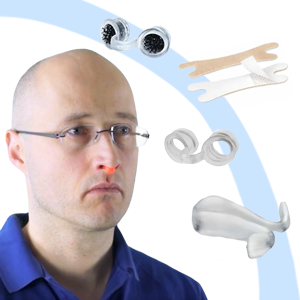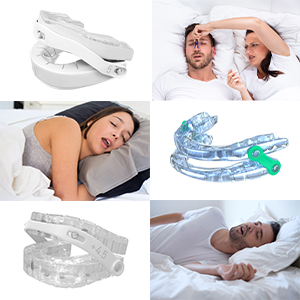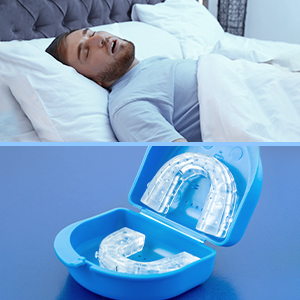Anyone suffering from an allergy is all too familiar with the problem of having a blocked nose. Allergens such as pollen irritate the mucous membranes and cause them to swell, typically hay fever snoring and breathing difficulties set in. At night allergies often lead to hay fever snoring and shortness of breath. Special nasal dilators with small air filters can help. We explain how this works.
Allergies and snoring
If the airways in the nose are narrowed due to hay fever snoring is more common. For one thing, you breathe in against resistance. This means that the entire upper respiratory tract is under a slight negative pressure. Everyone knows the feeling, you breathe in, but there is no air in the lungs, instead the nose (and also the throat) contracts. These constrictions in the airways can then result in turbulence in the airflow, causing the tissue in the nasopharyngeal cavity to vibrate. This creates the well-known snoring sound.
On the other hand, if the airway resistance in the nose is too high, the body unconsciously switches to mouth breathing, after all, you don’t want to suffocate! In many cases, however, mouth breathing leads to mouth snoring. This is because the flow of air through the mouth passes the tissue of the palate and in particular the arches of the palate, causing them to vibrate. These oscillations lead to noises, which we perceive as snoring.
The problem described here affects allergy sufferers among us to a large extent, because allergies to pollen and grass, house dust or animal hair lead to swelling of the nasal mucous membranes. Less air can flow in and out through the nose and one suffers from hay fever and snoring problems. But why do allergies occur in the first place?
Hypersensitivity reaction: Allergies and snoring
Put simply, an allergy is nothing more than a hypersensitivity reaction to substances from the environment. In classical snoring hay fever, the body’s immune system experiences a hypersensitive reaction to tiny particles in the air, in addition to house dust or animal hair allergies. These particles are between 1 and 100 micrometers in size. The smallest particles measure just one thousandth of a millimeter.
These small substances, for example certain protein molecules contained in some pollen, reach the mucous membrane of the nose via the inhaled air. Here immune cells whose task is to fight foreign substances and invading pathogens, are located. In the case of an allergy, these cells trigger an immune reaction against the normally harmless particles of house dust, cat hair or pollen. The substances released by the defense cells cause, among other things, the blood vessels in the mucous membrane of the nose to dilate and increasingly fill with blood. This causes the mucous membranes to swell. The nose becomes blocked and produces more secretions and the airways are narrowed by the swollen nasal mucous membranes. Not only do sufferers have breathing problems during the day , but breathing at night is often impossible due to snoring allergies and nasal congestion.
The problem with allergies is that there is no treatment that can completely eliminate the hypersensitivity. The only really effective method would be to completely avoid the substance responsible for the snoring allergies. But this is not feasible for the majority of allergies.

Air filter: trap allergen particles
One way of dealing with the allergy is to prevent the microscopic particles from reaching the mucous membrane of the nose in the first place. If the immune cells in the mucous membrane do not come into contact with the allergen (i.e. the allergenic substance), they are not activated and the respiratory tract remains free.
Nasal dilators with a built-in air filter are a simple and inexpensive way of protecting the mucous membranes from allergen particles. Nasal dilators, usually consist of two interconnected plastic rings that are pushed into the nostrils. They serve to widen the nostril and thus improve the respiratory flow. Some models are combined with an air filter that filters the allergenic particles out of the air when inhaled so that they cannot reach the mucous membranes. There are two different approaches:
1. Imitating the function of the nasal hairs
The nose already has a natural filter system for filtering the air we breath viz. the nasal hairs. They are designed to trap foreign particles from the air we breathe. When exhaling, the warm, moist air coats the fine hairs in the nose with a wafer-thin film of moisture. The particles of dirt that are sucked into the nose from the ambient air the next time the patient breathes in then stick to this film. However, as we usually do not have whole tufts of hairs in the nose, but only a manageable number, this method is not always effective. Especially not with tiny particles, house dust and sebaceous particles from animal hair or pollen are only a few micrometers in size and are often not intercepted by the nasal hair alone.
However, you can try to enhance the “nasal hair effect” by using a nasal dilator with a fine foam filter built into it. The fine foam has a very large surface due to its grid or net structure and resembles a “dense thicket of hairs”. During exhalation, this surface is moistened and heated by the air flowing out of the lungs. The next time you breathe in, the particles that would otherwise escape the natural nasal hairs get caught in this much denser mesh. The advantage of the foam models is that nasal breathing is not affected. You can therefore continue to breathe relatively easily through your nose because the foam has no or very low airway resistance. In other words, one does not have the feeling one is breathing through a filter or against a resistance.
But this advantage is also the disadvantage of the method: Some allergenic particles escape from the filter system, so that one cannot expect 100% protection against pollen or house dust from the nasal hair imitations.
All in all, however, nasal dilators with foam filters are an excellent aid against snoring allergies. Above all, they do not restrict your ability exert yourself, for example your ability to do sports without getting too little air through the filter. This type of filter is the perfect anti snoring device, in this instance.
2. Real filters
Another method is the installation of a real, fine plastic filter in the nasal dilator. Depending on the filter strength, these filters allow virtually no particles to pass through, thus ensuring extremely pure breathing air. In some models, the filters are also statically charged, so that the allergens are almost attracted by it and get caught. The products are available with different filter thicknesses. Depending on which allergy you suffer from, you can choose the right filter for you. For example, pollen is usually smaller than particles of sebum on animal hair, which is why a finer filter is recommended for snoring hay fever.
Filter models offer the advantage that they protect the nasal mucous membrane very effectively against allergenic particles in the air. Fine filters are even able to trap smoke particles.
However, they do have the disadvantage that breathing through the fine net is more difficult because the air must first pass through the filter. The problem with this is the same as with an allergy-induced congested nose. One breathes in against a resistance.
What is important with nasal filters?
Regardless of whether you choose the foam version or the finer filter models, there are a few points to consider when using them:
Limited durability
Nose dilators have a limited service life. Some models can even only be used once. This is due to hygienic reasons: Nasal dilators come into contact with secretions, which are often full of bacteria when worn. The nasal dilator often becomes a breeding ground for pathogens.
On the other hand, the physical absorption capacity of the filters is limited. If a larger amount of particles has got caught in the filter, the incoming breathing air can no longer be effectively cleaned. Figuratively speaking, the filter is “full”. Therefore, you should change your nasal filter regularly or at least at the bare minimum, every three months. However, there are also filter models that have to be cleaned daily with water and/or alcohol so that bacteria have no chance to thrive.
Correct size
It is important to choose the right size when buying. The nasal dilator must fit well, otherwise it may feel uncomfortable when worn for long periods of time. In addition, the dilators are made of stable, moulded plastic. This means that although they can be bent and deformed, they always return to their original shape. If they sit uncomfortably, this can quickly lead to a sensation of pressure. There are therefore many models in different sizes. They differ in diameter and shape to suit every nostril. But there are also so-called “one size fits all” products, such as somnipax pure.
Acclimatisation period
Initially wearing the nasal filters can be perceives as a rather unusual experience. However, one gets used to the foreign body in one’s nose quite quickly and after a while users are not bothered by it, especially during sleep.
Increased secretion flow
The nose itself also recognizes the nasal dilator as a foreign body and sometimes tries to get rid of it by its own means. In this instance your nose may produce more secretions to flush out the unfamiliar plastic object.
If this becomes too unpleasant for you, you should simply remove the nasal dilator, blow your nose and insert it again.
Get clean air vs. good air
Especially with real filters, nasal breathing can be impaired. Since the filter is very fine, one is able to inhale less air through the nose. If you want to keep getting good quality air, you have to exert yourself more and breathe in and out more vigorously. This can be quite unusual in the beginning. One should try to prevent the body from seeking “the path of the least resistance” and switching to mouth breathing , because the filter loses its function as a result. One can train oneself to consciously breathe through one’s nose – especially if one does it right from the start.
The higher resistance makes the nasal filters unsuitable for use in sports. Here it is important that you get enough oxygen and a filter would only be a hindrance here. Even for use at night – keyword “how to stop snoring” – the air filter takes some getting used to. A foam filter might be more helpful in this instance.
Nasal dilator purchasing advisor
What must you take into consideration when making a purchase? See all our nasal dilators presented here.
Positional therapy purchasing guide
Helps you make an informed buying decision when buying a positional therapy device, such as an anti-snoring vest or anti-snoring backpack.
Mandibular advancement device (MAD) purchasing guide
Advises you what you should pay attention to when buying a mandibular advancement device (MAD). We present different models and technical approaches here.
Mandibular advancement device guide – answers based on practical experience
Mandibular advancement devices can help with sleep apnoea in a lot of cases. They are now also provided by the NHS. Find out how exactly they can help, and when they are provided by the NHS.

Medical Doctor, Berlin
Jan Wrede works as a medical doctor in Berlin. He studied medicine at FAU University in Erlangen-Nuremberg and Semmelweis University in Budapest. He had already written numerous scientific articles during his studies, especially on the subject of snoring.









 Welcome to SomniShop
Welcome to SomniShop